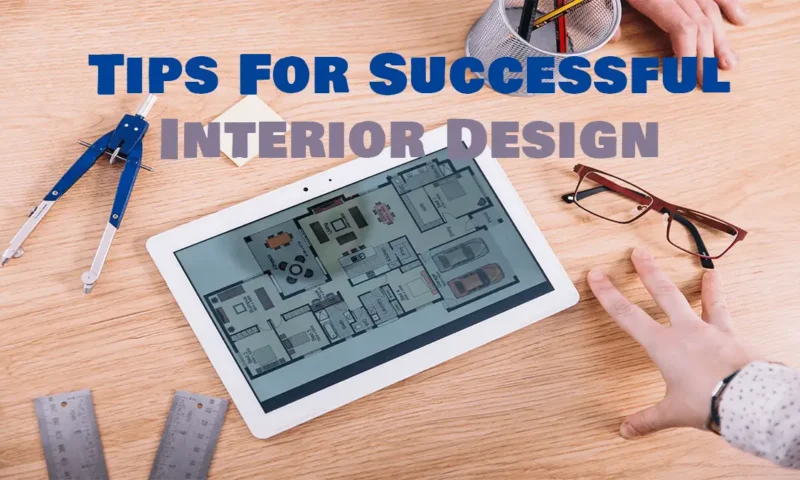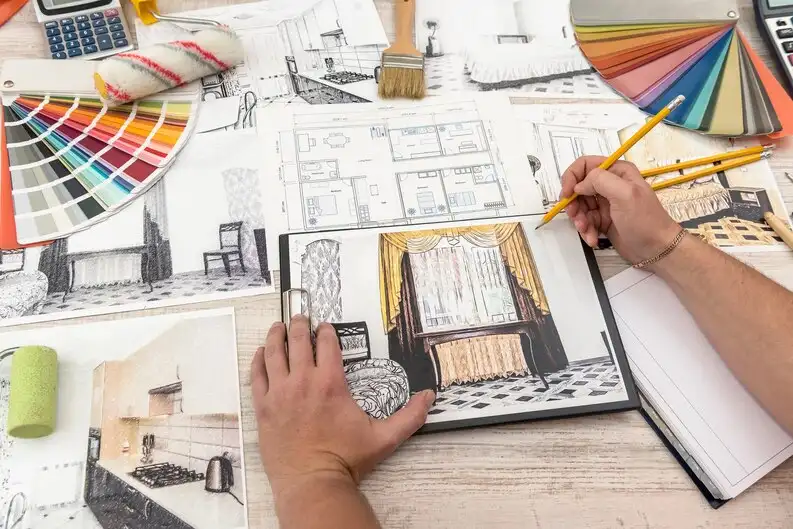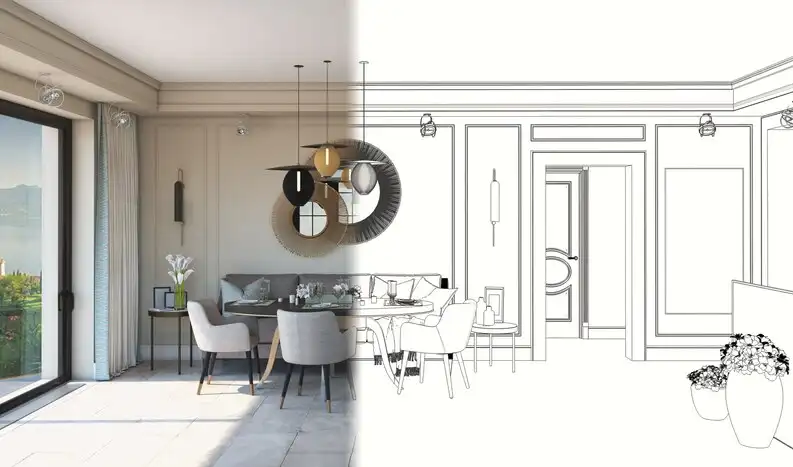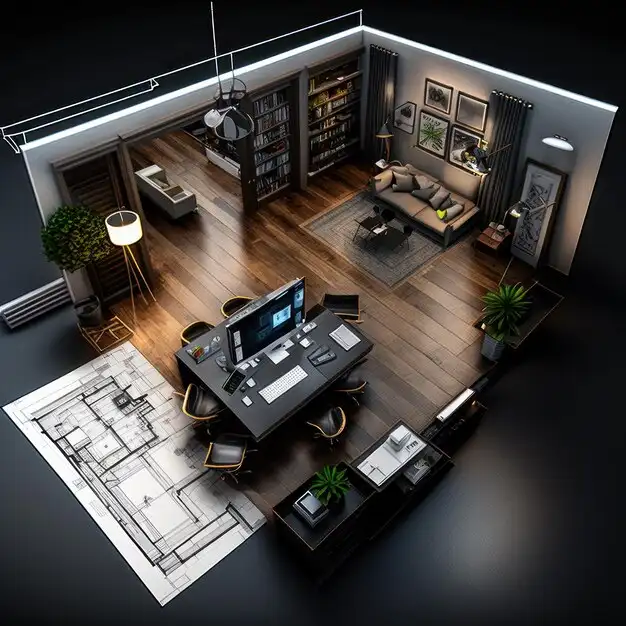
Introduction
Interior design is the art and science of enhancing the appearance and functionality of a space, according to the needs and preferences of the people who use it. Interior design can transform any room, from a living room to a bedroom, from a kitchen to a bathroom, into a comfortable, stylish, and personalized environment.
But how do you create a successful interior design project from scratch? What are the steps, the principles, and the tools you need to know? And where can you find inspiration and guidance for your interior design journey?
In this article, we will answer these questions and more, with tips and resources for beginners who want to learn more about interior design. We will also explore the latest interior-design trends for 2024 and beyond, and how to incorporate them into your own space.
Whether you want to redecorate your home, start a career in interior design, or simply satisfy your curiosity, this article will help you discover the fascinating world of interior-design and how to make the most of it.
Also read: Design programs » Moumentec
What is interior design and why is it important?
Interior design is the process of planning, designing, and decorating the interior of a building or a space, using various elements such as furniture, lighting, color, texture, materials, and accessories. Interior design aims to create a space that is aesthetically pleasing, functional, and comfortable, as well as reflecting the personality, taste, and lifestyle of the people who use it.
Interior design is important for many reasons. First of all, interior design can improve the quality of life of the people who live or work in a space, by providing them with a suitable environment for their needs and activities. For example, interior-design can create a cozy bedroom for relaxation, a productive home office for work, or a fun playroom for kids.
Secondly, interior design can enhance the value and appeal of a property, by making it more attractive, modern, and unique. For example, interior-design can increase the resale value of a house, attract more customers to a store, or impress guests at a hotel.
Thirdly, interior design can express the identity and culture of the people who use a space, by reflecting their preferences, interests, and values. For example, interior design can showcase the personal style of a homeowner, the brand image of a business, or the history of a place.
How to plan your interior design project
Before you start designing your space, you need to plan your interior design project carefully. Planning is essential to avoid mistakes, save time and money, and achieve the best results. Here are some steps to follow to plan your interior design project:
Define your goal:
What is the purpose of your interior design project? What do you want to achieve with your space? What are your needs, expectations, and budget? Write down your goal and keep it in mind throughout the project.
Assess your space:
What are the dimensions, shape, and layout of your space? What are the existing features, such as windows, doors, walls, floors, and ceilings? What are the strengths and weaknesses of your space? Take measurements and photos of your space and make a floor plan.
Gather inspiration:
What are the styles, colors, textures, materials, and accessories that you like and dislike? What are the mood and atmosphere that you want to create in your space? Browse magazines, books, websites, blogs, social media, and online platforms, such as Pinterest, Houzz, or Instagram, to find interior design ideas that inspire you. Save or print the images that you like and create a mood board or a collage to visualize your concept.
Choose your style:
What is the interior design style that suits your space, your goal, and your personality? There are many interior-design styles to choose from, such as modern, traditional, rustic, eclectic, bohemian, Scandinavian, minimalist, industrial, and more. You can also mix and match different styles to create your own unique look. Research the characteristics, elements, and examples of each style and decide which one you want to follow.
Select your color scheme:
What are the colors that you want to use in your space? Colors can have a big impact on the appearance and mood of your space, so choose them carefully. You can use a color wheel to help you find harmonious combinations of colors, such as monochromatic, complementary, analogous, triadic, or tetradic. You can also use online tools, such as Adobe Color, Coolors, or Colormind, to generate color palettes based on your preferences or inspiration images. Choose a main color, a secondary color, and an accent color, and use them in different proportions and locations in your space.

Pick your furniture:
What are the furniture pieces that you need and want in your space? Furniture is one of the most important elements of interior design, as it provides function, comfort, and style to your space. You can use online platforms, such as Wayfair, Ikea, or Amazon, to browse and buy furniture online, or visit local stores, flea markets, or thrift shops to find unique and affordable pieces. You can also reuse, repurpose, or customize your existing furniture to give it a new look. Choose furniture that fits your space, your style, and your budget, and arrange it in a way that creates a good flow and balance in your space.
Add your lighting:
What are the lighting sources that you have and need in your space? Lighting is another essential element of interior design, as it affects the visibility, ambiance, and mood of your space. You can use natural lighting, such as sunlight, or artificial lighting, such as lamps, wayfair, or candles, to illuminate your space. You can also use different types of lighting, such as ambient, task, or accent, to create different effects and layers in your space. Choose lighting that matches your style, your color scheme, and your furniture, and place it in strategic locations to highlight or hide certain features in your space.
Accessorize your space:
What are the accessories that you want to use in your space? Accessories are the finishing touches that complete your interior design project, by adding personality, interest, and charm to your space. You can use various accessories, such as rugs, pillows, throws, curtains, artworks, mirrors, plants, books, candles, vases, baskets, and more, to decorate your space. Choose accessories that complement your style, your color scheme, and your furniture, and arrange them in a way that creates a focal point, a contrast, or a harmony in your space.
Interior design tips for beginners
If you are new to interior design, you might feel overwhelmed or intimidated by the process. But don’t worry, interior-design can be fun and rewarding, if you follow some simple tips and tricks. Here are some interior design tips for beginners that will help you create a successful interior-design project:
Start small:
If you are not confident or experienced in interior design, it is better to start with a small project, such as a single room, a corner, or a wall, rather than a whole house or a large space. This way, you can practice your skills, test your ideas, and learn from your mistakes, without spending too much time, money, or effort. You can also focus on one element at a time, such as color, furniture, or lighting, and gradually build up your project.
Follow the rule of three:
A simple and effective way to create a cohesive and balanced interior design is to follow the rule of three. This means that you should use three colors, three textures, three materials, or three shapes in your space, and repeat them in different proportions and locations. For example, you can use three colors, such as blue, white, and yellow, and use them in a 60-30-10 ratio, where 60% is the main color, 30% is the secondary color, and 10% is the accent color.
You can also use three textures, such as wood, metal, and fabric, and use them in different furniture, lighting, and accessories. You can also use three materials, such as glass, stone, and leather, and use them in different surfaces, walls, and floors. You can also use three shapes, such as circles, squares, and triangles, and use them in different artworks, pillows, and rugs.
Use the 60-30-10 rule:
Another simple and effective way to create a harmonious and attractive interior design is to use the 60-30-10 rule. This means that you should use 60% of one color, 30% of another color, and 10% of a third color in your space. The 60% color is the dominant color, and it should be a neutral or a light color, such as white, beige, or gray.
The 30% color is the secondary color, and it should be a contrasting or a complementary color, such as blue, green, or red. The 10% color is the accent color, and it should be a bright or a bold color, such as yellow, pink, or orange. You can use these colors in different elements, such as walls, furniture, and accessories, to create a visual hierarchy and interest in your space.
Use the golden ratio:
A more advanced and sophisticated way to create a proportional and pleasing interior design is to use the golden ratio. This is a mathematical ratio that is
found in nature, art, and architecture, and it is approximately equal to 1.618. The golden ratio can help you create a harmonious and balanced interior design, by dividing your space or your elements into two parts, where the ratio of the larger part to the smaller part is equal to the ratio of the whole to the larger part.
For example, you can use the golden ratio to determine the size and position of your furniture, artwork, or accessories, by using a calculator, a ruler, or a tape measure. You can also use the golden ratio to create a focal point, a symmetry, or an asymmetry in your space, by using a grid, a spiral, or a rectangle based on the golden ratio.
What skills do you need to become an interior designer?
To become a successful interior designer, you need to develop a range of skills, both technical and creative. Some of the most important skills are:
Creativity:
You need to have a good eye for color, shape, form, and balance, and be able to come up with original and innovative ideas that suit the needs and wants of your clients or yourself.
Communication:
You need to be able to communicate effectively with your clients, suppliers, contractors, and other professionals involved in the project, and be able to present your ideas clearly and persuasively, using verbal, written, and visual methods.
Problem-solving:
You need to be able to analyze the requirements, challenges, and constraints of a project, and find solutions that meet the budget, timeline, and quality standards.
Organization:
You need to be able to plan, manage, and coordinate the various stages and tasks of a project, from research and design to implementation and evaluation, and keep track of the details, documents, and deadlines.
Technology:
You need to be familiar with the software and tools that are used in the interior design industry, such as computer-aided design (CAD), 3D modeling, rendering, and drafting, as well as online platforms and applications that can help you create, share, and showcase your work.
Interior design resources for beginners
If you want to learn more about interior design or get some help and guidance for your interior-design project, there are many resources available for beginners. Here are some of the best interior design resources for beginners that you can use:

Books:
Books are a great way to learn the basics, the history, and the trends of interior design, as well as to find inspiration and tips for your own space. Some of the best books for beginners are:
Interior Design Course: Principles, Practices, and Techniques for the Aspiring Designer by Tomris Tangaz. This book is a comprehensive and practical guide to interior design, covering the theory, the process, and the practice of interior-design, with examples, exercises, and projects.
The Interior Design Handbook: Furnish, Decorate, and Style Your Space by Frida Ramstedt. This book is a simple and accessible guide to interior-design, covering the principles, the rules, and the tricks of interior design, with illustrations, diagrams, and checklists.
Styled: Secrets for Arranging Rooms, from Tabletops to Bookshelves by Emily Henderson. This book is a fun and inspiring guide to interior design, covering the styles, the colors, and the accessories of interior design, with photos, quizzes, and tips.
Websites:
Websites are a great way to stay updated, informed, and inspired by interior design, as well as to find products, services, and advice for your own space. Some of the best websites for beginners are:
Apartment Therapy: This website is a popular and trusted source of interior-design, covering the trends, the ideas, and the solutions of interior design, with articles, videos, and photos.
Houzz: This website is a leading and innovative platform of interior design, covering the products, the professionals, and the projects of interior-design, with catalogs, portfolios, and reviews.
Decorilla: This website is a convenient and affordable service of interior design, covering the design, the shopping, and the installation of interior design, with online consultations, 3D renderings, and discounts.
Apps:
Apps are a great way to experiment, create, and visualize your interior design project, as well as to find inspiration and feedback for your own space. Some of the best apps for beginners are:
Pinterest: This app is a popular and powerful tool of interior-design, allowing you to discover, save, and organize interior design ideas, with boards, pins, and collections.
RoomSketcher: This app is a user-friendly and professional tool of interior design, allowing you to draw, design, and furnish your interior design project, with floor plans, 3D models, and virtual tours.
Homestyler: This app is a fun and interactive tool of interior-design, allowing you to decorate, style, and transform your interior design project, with realistic products, 3D renderings, and live feedback.
What tools do you need to create an interior design project?
To create an interior design project, you need to have some essential tools that can help you with the different aspects of the process. Some of the most common tools are:
- Measuring tape: You need to measure the dimensions of the space and the furniture, fixtures, and accessories that you want to use, to ensure that they fit and are proportionate to the scale of the room.
- Sketchbook and pencils: You need to sketch your ideas and concepts, and make notes and annotations, to visualize and refine your design.
- Mood board: You need to create a collage of images, colors, fabrics, materials, and samples that represent the style, theme, and mood of your design, and use it as a reference and inspiration.
- Color wheel: You need to use a color wheel to understand the relationships and effects of different colors, and choose a color scheme that suits the purpose and atmosphere of your design.
- Fabric and material swatches: You need to have samples of the fabrics and materials that you want to use in your design, to test how they look and feel in the space, and how they match with the other elements.
- Computer and software: You need to use a computer and software to create digital drawings, models, and renderings of your design, and to edit, modify, and print your work.
- Camera and portfolio: You need to use a camera to take photos of your finished design, and to create a portfolio that showcases your work and skills.
Interior design trends for 2024 and beyond
Interior design is a dynamic and evolving field, that is influenced by various factors, such as technology, culture, environment, and lifestyle. As a result, interior-design trends change and emerge every year, reflecting the needs, preferences, and values of the people who use them. Here are some of the interior design trends that are expected to dominate in 2024 and beyond:
Biophilic design:
Biophilic design is a trend that focuses on connecting people with nature, by incorporating natural elements, such as plants, water, light, and air, into the interior design. Biophilic design aims to create a space that is healthy, sustainable, and relaxing, by improving the air quality, the energy efficiency, and the mood of the space. Some of the ways to achieve biophilic design are:
- Using indoor plants, such as succulents, ferns, or herbs, to add color, texture, and freshness to the space.

- Using natural materials, such as wood, stone, or bamboo, to add warmth, character, and durability to the space.
- Using natural lighting, such as skylights, windows, or mirrors, to add brightness, spaciousness, and rhythm to the space.
- Using natural sounds, such as waterfalls, fountains, or wind chimes, to add calmness, harmony, and diversity to the space.
Smart design:
Smart design is a trend that focuses on integrating technology with interior design, by incorporating smart devices, such as sensors, cameras, speakers, or screens, into the interior-design. Smart design aims to create a space that is convenient, efficient, and personalized, by enhancing the functionality, the security, and the comfort of the space. Some of the ways to achieve smart design are:
- Using smart lighting, such as LED bulbs, dimmers, or timers, to adjust the brightness, the color, and the timing of the lighting according to the needs and preferences of the user.
- Using smart thermostats, such as Nest, Ecobee, or Honeywell, to control the temperature, the humidity, and the ventilation of the space according to the weather and the schedule of the user.
- Using smart assistants, such as Alexa, Google Home, or Siri, to control the devices, the entertainment, and the information of the space using voice commands or gestures.
- Using smart security, such as Ring, Arlo, or SimpliSafe, to monitor the activity, the access, and the alerts of the space using cameras, locks, or alarms.
Minimalist design:
Minimalist design is a trend that focuses on simplifying and decluttering the interior design, by reducing the elements, such as furniture, accessories, or colors, to the essential and functional ones. Minimalist design aims to create a space that is elegant, spacious, and serene, by eliminating the distraction, the waste, and the stress of the space. Some of the ways to achieve minimalist design are:
- Using multifunctional furniture, such as sofa beds, storage ottomans, or folding tables, to save space, money, and effort.
- Using neutral colors, such as white, black, or gray, to create a clean, sleek, and timeless look.
- Using geometric shapes, such as circles, squares, or triangles, to create a simple, modern, and harmonious look.
- Using negative space, such as empty walls, floors, or corners, to create a sense of openness, balance, and contrast.
Conclusion
Interior design is a creative and rewarding activity, that can transform any space into a beautiful, functional, and personal environment. Interior-design can also improve the quality of life, the value of the property, and the identity of the people who use the space. However, interior design can also be challenging and complex, especially for beginners who lack the knowledge, the experience, or the confidence to create their own interior design project.
That is why it is important to plan, research, and learn about interior design, before starting the design process. In this article, we have provided you with some tips and resources for beginners who want to learn more about interior design. We have also introduced you to some of the interior-design trends that are expected to dominate in 2024 and beyond, and how to incorporate them into your own space.
We hope that this article has inspired you, informed you, and helped you with your interior design project. Remember, interior design is not a fixed or a rigid discipline, but a flexible and a fun one that can help you express your creativity and personality. However, you don’t have to follow any trend blindly, but rather adapt it to your own space, goal, and taste.
Frequently asked questions and answers
Here are some of the frequently asked questions and answers about interior design for beginners:
Q: How do I find my interior design style?
A: Finding your interior design style can be a fun and rewarding process, but it can also be challenging and confusing, especially if you are not sure what you like or dislike. Here are some steps to help you find your interior-design style:
- Take a quiz: You can take an online quiz, such as this one, to find out what interior design style matches your personality, preferences, and lifestyle. You can also take a quiz with your partner, family, or friends, to see if you have similar or different styles.
- Look around: You can look around your own space, or other spaces that you visit, such as your friends’ homes, hotels, restaurants, or museums, and see what elements, such as furniture, colors, or accessories, catch your eye and make you feel happy, comfortable, or inspired.
- Create a vision board: You can create a vision board, either physically or digitally, to collect and organize interior design ideas that you like. You can use magazines, books, websites, blogs, social media, or online platforms, such as Pinterest, Houzz, or Instagram, to find interior design images that appeal to you. You can then group them by categories, such as style, color, texture, or material, and see if you can find a common theme or pattern among them.
Q: How do I budget for my interior design project?
A: Budgeting for your interior design project can be a tricky and stressful task, but it can also help you save money, time, and effort, and avoid unnecessary expenses, mistakes, or regrets. Here are some steps to help you budget for your interior-design project:
- Estimate your costs: You can estimate your costs by listing all the elements that you need and want for your interior design project, such as furniture, lighting, color, accessories, and labor. You can then research the prices of each element, either online or in stores, and add them up to get a total amount. You can also use online calculators, such as this one, to get an approximate cost of your interior-design project based on your space, style, and quality.
- Set your priorities: You can set your priorities by ranking the elements that you need and want for your interior design project, from the most important to the least important. You can then allocate your budget accordingly, and decide which elements you can splurge on, which elements you can save on, and which elements you can skip or postpone.
- Track your spending: You can track your spending by keeping a record of all the receipts, invoices, and bills that you receive for your interior design project. You can also use online tools, such as Mint, YNAB, or Excel, to create and manage your budget, and see how much you have spent, how much you have left, and how much you have saved or overspent.




